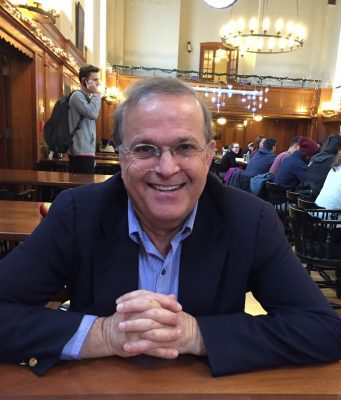Prof. Emeritus Winthrop Smith and former student Prof. Douglas Goodman (Quinnipiac University) Edit Special Issue of Open Access Journal Atoms, on Low Energy Interactions between Ions and Ultracold Atoms
The Special Issue of the online journal Atoms is a collection of current peer-reviewed articles by experts in the field of ultracold collisions and reactions involving ions and atoms co-trapped by electromagnetic fields in a common volume (a hybrid ion-neutral trap). Prof. Goodman, a recent UConn Ph.D. student of Prof. Smith (2015) who worked with hybrid traps for his dissertation, is now on the faculty of Quinnipiac University in Hamden, CT.
Prof. Smith’s research, on which he supervised four doctoral dissertations over the last few years, centers around the study of low-energy ion-neutral collisions. At long range, universal types of charge-induced polarization effects produce very large elastic, inelastic, reactive, and charge-transfer cross-sections leading to a high interaction probability between ions and neutral atoms at low temperature. The Special Issue articles highlight recent experimental and simulation work in this field and discuss the outlook for future developments.
Two of the manuscripts in this Special Issue explore recent advances in hybrid trap technology. The paper by Prof. Karpa explains the use of bichromatic optical dipole traps, which can be used instead of the previously developed hybrid rf ion trap and magneto-optic trap. This remarkable new technique avoids the use of rf fields and associated micromotion heating limitations and allows access to the long-sought quantum-dominated regime of interaction.
Karpa, L. Interactions of Ions and Ultracold Neutral Atom Ensembles inComposite Optical Dipole Traps: Developments and Perspectives. Atoms2021, 9(3), 39; https://doi.org/10.3390/atoms9030039 The manuscript included by Prof. Denschlag’s team, early practitioners of hybrid-trap ion-neutral studies, introduces a novel type of low-energy reaction. Denschlag’s group discusses the interaction between an atomic ion and an atom with a valence electron in a highly excited Rydberg state that reacts to yield a long-range atom-ion Rydberg molecule, with binding lengths up to the micrometer scale.Deiß, M.; Haze, S.; Hecker Denschlag, J. Long-Range Atom–Ion RydbergMolecule: A Novel Molecular Binding Mechanism. Atoms 2021, 9(2), 34;https://doi.org/10.3390/atoms9020034 https://www.mdpi.com/2218-2004/9/2/34
The remaining two manuscripts in this Special Issue address important phenomenology of rf Paul traps as they are used in ion-neutral interaction experiments. The paper by Prof. Blumel analyzes the properties of ion clouds loaded from a magneto-optical trap in a hybrid ion-neutral system. He develops theoretical predictions for optimal loading conditions for hybrid-trap experiments, which are supported by numerical simulations. Additionally, he predicts the existence of a new type of ion heating mechanism caused by the increase in Coulomb energy associated with each newly loaded ion within the existing ion-cloud volume.
Blümel, R. Loading a Paul Trap: Densities, Capacities, and Scaling inthe Saturation Regime. Atoms 2021, 9(1), 11; https://doi.org/10.3390/atoms9010011https://www.mdpi.com/2218-2004/9/1/11
Last, the manuscript by Prof. Rangwala’s group, numerically and analytically explores the benefits of using linear multipole rf traps for studying low-energy ion-neutral collisions, as opposed to the conventional quadrupole ion-trap configuration. Using new analyses of the heating effects, Rangwala’s group shows that the higher-order multipolar trap configurations reduce unwanted heating in the ion-neutral system. In doing so, they develop a methodology for comparing and optimizing hybrid trap designs.
Niranjan, M.; Prakash, A.; Rangwala, S. Analysis of Multipolar Linear
Paul Traps for Ion–Atom Ultracold Collision Experiments. Atoms 2021,
9(3), 38; https://www.mdpi.com/2218-2004/9/3/38
https://doi.org/10.3390/atoms9030038

